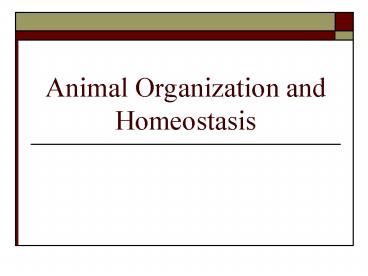Animal Organization and Homeostasis - PowerPoint PPT Presentation
1 / 20
Title:
Animal Organization and Homeostasis
Description:
Animal Organization and Homeostasis Tissues Specialized cells of the same type that perform a common function in the body Types Epithelial Connective Muscular Nervous ... – PowerPoint PPT presentation
Number of Views:80
Avg rating:3.0/5.0
Title: Animal Organization and Homeostasis
1
Animal Organization and Homeostasis
2
Tissues
- Specialized cells of the same type that perform a
common function in the body - Types
- Epithelial
- Connective
- Muscular
- Nervous
3
Epithelial tissue
- Covers surfaces and lines body cavities
- Mostly functions in protection
- Exposed to environment on 1 side, basement
membrane on the other that anchors it to the
connective tissue - Named according to shape of cell
- Squamous (flat), cuboidal (cube) and columnar
(column) - Stratified (layered), pseudosratified (looks
layered)
4
(No Transcript)
5
Glandular epithelial
- Secretes a product
- Exocrine
- into a duct
- Endocrine
- into the blood stream
6
Connective tissue
- Most abundant
- Each type has
- specialized cells
- Ground substance
- Protein fibers
- Types
- Fibrous connective
- (loose and dense)
- Adipose
- Cartilage
- Bone
- blood
7
Fibrous connective tissue
- Contain fibroblast cells within a gel matrix
- Loose fibrous support
- Adipose energy reservoir, insulation
- Dense fibrous found in tendons and ligaments,
contains collagen fibers
8
Supportive connective tissue
- Cartilage cells in chambers called lacunae
surrounded by a gel like matrix - 3 types of cartilage (based on fibers in matrix)
- Hyaline most common, fine collagen fibers
- Elastic - more flexible
- Fibrocartilage strong collagen fibers
9
Bone
- Hard matrix of inorganic salts around protein
fibers - Compact bone shaft of long bones
- Cylindrical structures called osteons
- Bone cells found within lacunae
- Spongy bone end of long bones
- Contains bony bars and plates with space between
- Built for strength
10
Fluid Connective Tissues
- Blood formed elements and plasma
- Hematopoiesis production of blood cells, in red
bone marrow - Transports nutrients and oxygen to tissue fluid,
distribute heat and fluid, ion and pH balance - RBCs small, no nucleus, round
- WBC larger, have a nucleus, phagocytes, produce
antibodies - Platelets involved in blood clotting
- Lymph in lymph vessels, absorbs excess fluid
11
Muscular tissue
- Made of cells called muscle fibers
- Actin thin, myosin thick
- Movement and generation of heat
- 3 types
- Skeletal voluntary, striated
- Smooth visceral, involuntary, no striations
- Cardiac muscles of the heart, involuntary,
striated, intercalated disks
12
(No Transcript)
13
Nervous tissue
- Contain neurons (1 trillion on average)
- 3 parts axon, cell body, dendrite
- Functions in sensory input, integration of data,
and motor output - Neuroglia support and nourish neurons
- Microglia - phagocyte
- Astroglia provide nutrients
- Oligodendroglia form myelin in brain
14
Organs and organ systems
- Organ 2 or more types of tissues working
together to perform the same function - Organ system organs working together to carry
out a process
15
Skin
- Largest organ
- Functions for protection and thermoregulation
- Contains receptors that monitor touch, pressure,
temperature - and pain
- Epidermis
- Dermis
- subcutaneous
16
Epidermis
- Stratified squamous
- Hair follicles, sebaceous glands, sweat glands
- Skin cells are pushed to surface of skin and
slough off - Melanocytes cells that produce melanin,
pigment, UV rays induce production (vit.D) - Basal cell carcinoma and malignant melanoma are
types of skin cancer
17
Dermis and Subcutaneous
- Contains collagen and elastic fibers
- Overstretching due to fast weight gain can cause
stretch marks - Blood vessels and sensory receptors
- Subcutaneous not true part of skin, source of
energy, produces padding, overall rounded
appearance
18
Accessory organs of the skin
- Nails protective covering, can be useful
medically - hair begin in dermis, extend out of epidermis,
dead, hardened epidermal cells - Each follicle has an oil gland that when clogged,
produces white heads or black heads (oxidized
sebum) - Glands sweat (sudoriferous)
19
Organ systems
- 2 main body cavities
- Dorsal (cranial and vertebral cavity)
- Ventral (thoracic, abdominal and pelvic cavity)
20
Homeostasis
- Maintaining and internal balance
- Negative feedback keeps a variable close to a
particular value ex. body temp. - Positive feedback brings a greater change in
the same direction ex. Oxytocin and birth































